|
FAQs about Mussid Coral Identification
2
Related Articles: Mussid
Corals,
Related FAQs: Mussid
Identification 1, Mussid ID 3,
Mussid ID 4, & Mussid FAQs 1, Mussid FAQs 2, Mussid Behavior, Mussid Compatibility, Mussid Selection, Mussid Disease, Mussid Systems, Mussid Feeding, Mussid Reproduction, Stony/True Coral, Coral System Set-Up, Coral System Lighting, Stony Coral Identification, Stony Coral Selection, Coral Placement, Foods/Feeding/Nutrition, Disease/Health, Propagation, Growing Reef Corals, Stony Coral Behavior,
|

|
|
coral ID 6/30/10
Dear crew,
I got so many good tips from you and your site. Every morning I
print a few pages, and then during my lunch brake
<Urrhhhhh!>
I read them.
I'm planning to get this coral. It has ID as Blastomussa.
However, one guy from the shop told me , that he has the same
kind and keeps it on a top of his LR with SPS, and it is doing
good. Please help to identify it for a proper care.
Thank you so much.
Best regards,
Igor
<A Mussid in any case. Read here: http://wetwebmedia.com/mussidae.htm
and the linked files above.
BobF>
|
 |
Re: coral ID... Mussid
sys. 7/1/10
Thank you Bob very much for a fast response.
I guess a light requirement for both , Acan and Blasto is similar,
right?
Best wishes,
Igor
<I do think so. BobF> |
|
Micromussa/Coral ID 3/2/10
Hi there,
<Hello Mark>
Shamelessly abusing your generous service yet again! Thanks!
<Welcome.>
I bought an established tank to pillage the corals and equipment
and received a piece I was hoping you could help ID. I was told
it was a Blasto, I think it is a Micromussa, have been told on
forums it is an Acan.
Your thoughts on the matter would be appreciated and also if you
dont mind giving me an idea of the 'grade' of this
particular piece you would be helping me out greatly. There is a
bit of algae I need to get cleaned off and it could use some love
but otherwise it is a nice looking coral.
<My best guess is what you were told, a Blasto. Both the
Blastomussa and Acanthastrea are from the same family, Mussidae,
which contain many species. I do not believe you have a
Micromussa as these corals are quite rare and command prices of
150.00 and upward for a small frag. To accurately identify your
specie would take more time than we have to do so.
I suggest getting a book dedicated to corals such as
Borneman's works.>
Thanks again,
<You're welcome. James (Salty Dog)>
Mark
|
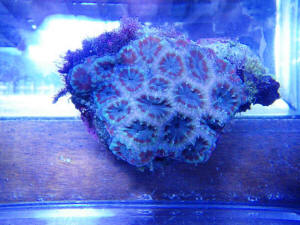 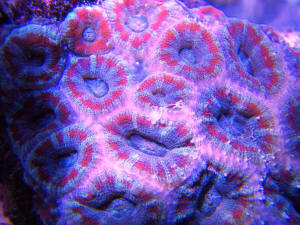 |
|
Unidentifiable Coral -- 11/09/2009
<... why don't folks follow directions when asking our
help? Why are you sending 16 megs of pix? Ho buoy!>
I have asked the owner, I have asked ReefCentral, and I have
asked TheReefTank.com, and I have yet to get a straight
answer.
<Mmm... what's the question?>
I have this beautiful coral which I believe is LPS, but could
POSSIBLY be SPS.
<An artificial designation... of limited value>
I have a couple of different pictures of it.
The first is of the coral about 1 hour after it was first put in
the tank.
The second picture is of it when it's completely and fully
extended.
The third picture is another picture of the coral when it's
completely and fully extended, but you can also see the corals
calcium skeleton, I think that may help some?
The last picture is of it at night (lights out).
The best answers I have gotten are Tongue Coral and Encrusting
Hydnophora.
<? I don't think so>
But it's still a small specimen and very hard to tell what it
is.
It's about the size of a half dollar coin and is a lightish
pink color.
Please and thank you!
-Zack
<Looks to be some species of Symphyllia... a Mussid. Bob
Fenner>
|
.JPG) 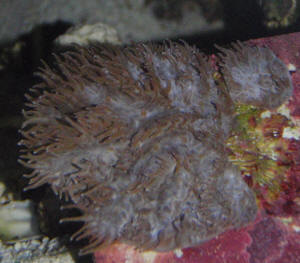 |
Re: Unidentifiable Coral --
11/09/2009
I apologize about the pic size!
I guess I forgot about that rule.
<Heeeee! We're fresh out of disk space!>
But do you have a good comparison picture?
<Mmm, I'll look>
I searched for Mussids and Symphyllia on Google images and got
nothing that looked like it.
<Mmm, no... just looked... All mine are large specimens, during
the day, with flesh retracted. BobF> |
|
Coral identification 3/14/09
Hi Crew.
<Hi there.>
Thanks for all you do.
<On behalf of Bob and the crew you're welcome.>
I purchased this frag at a swap, and was told it was an
Acanthastrea, but no further information.
<OK.>
Can you verify whether this is an Acan, and give me any idea
which sub species it belongs to?
<Mmm, It could be a Acan, but I'm at a reef conference and
the general consensus here it that it looks like a Blasto.
Unfortunately these corals can be difficult if not impossible to
identify without analyzing the
skeleton. More here:
http://www.wetwebmedia.com/mussidae.htm>
Also, it is currently near the top of my tank under 2 150 watt
metal halides. It seems to be doing OK, but would you recommend
lower lighting?
<Yes to acclimate.>
Thanks!
|
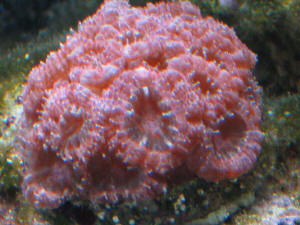 |
Re: Coral identification
3/18/09
Thanks. Acan and Blasto care is the same right?
<Generally yes, Though Acans may tolerate more light than
Blastos as Acans can be found in shallower waters. Blastomussa have
moderate lighting requirements and will eat finely chopped meaty
bits, they are generally found in turbid waters and usually
don't like a lot of flow. More here:
http://reefkeeping.com/issues/2005-08/ebac/index.php
Cheers,
Mich>
Thanks. Acan and Blasto care is the same right?
<See the last email.>
(But don't the "teeth" look more Acan?)
<Is possible.
Cheers,
Mich> |
Australian Coral Identification
9/17/08 Good Afternoon! Great website, has helped me plenty to
advance in the excellent hobby of reefkeeping. Just a quick question
this time. I am starting to get into the Australian corals now in the
market. I try my best to avoid corals harvested illegally (I hear many
are being harvested off the coast of Japan) and I am trying to better
educate myself. How can you tell the difference between Lord Acans,
Micromussas and Blastomussa? <Mmm, most of these Mussids can be
distinguished from gross examination... do you have J.E.N. Veron's
in-print works on Scleractinians? These are the paramount guides for ID
here. Otherwise, free on-line work can be found by our own Sara
Mavinkurve (Asira.com) and Jake Adams (Coralidea.com)> I bought
frags off a local reefer and cannot identify them. Would pictures help?
<Oh yes> Are there any characteristics that can be used to
identify them? <... yes> From what I hear, Micromussas are just a
smaller version (8mm or less) of Lord Acans. Any help is greatly
appreciated! <Do see the ref.s above. Bob Fenner>
Acanthastrea ID 05/09/08 Can
you help me ID this? I'm thinking about getting a frag.
It's identified as Acanthastrea Maxima. I understand this type
of coral is mis-identified with some regularity. <It's
certainly not easy to ID a coral down to a species without a close
look at the dead skeleton... sorry.> What do you think?
<Personally, I don't think it's A. maxima. But again,
it's hard to say and I could certainly be wrong. This might
help:
http://www2.aims.gov.au/coralsearch/html/901-1000/Species%20pages/911.htm>
Thanks for the help and for the rest of the info here on this
amazing site. <De nada,
Sara M.> |
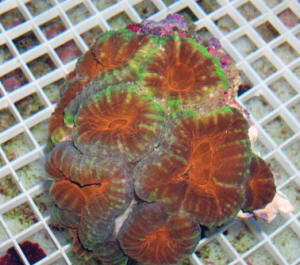 |
|
Is this a Favia or Mussa? Mussid... ID,
fdg., sys.... using WWM 2/19/08
Howdy! Great site! I've been back and forth with folks over
the last month or so, and at various times was sure the piece of
coral I had was a Blastomussa, and at others that it was a Favia.
Now I'm not certain, so I figured I'd check with the
experts. <Mmmm> Here is a picture of the coral just after I
first put it in the tank: I have tried feeding it Cyclop-Eeze
when the polyps (that's what I call them, not sure if
that's what they are) are open. When they are open, they
almost look like little red crowns with fingery things with tiny
balls on top, almost like a king's crown. It's really
difficult to say whether they eat the shrimp or not. The bits
that end up in the crevices between the polyps tend to decay. In
the above photo you can see in the bottom-left crevice a bit of
rotting CP. On at least two occasions, I have seen that area get
overgrown with a white gooey film that eventually releases and
floats in the water column, attached by a thread or two to the
area between the polyps (or so it seems). It eventually goes
away. Below is a most recent photo. It looks like it has some red
slime algae on it: <Not good...> I have had it for
approximately one month. I am eager figure out what exactly this
piece of coral is. <Looks like a Blastomussa to me> It does
not appear as though it has grown at all. I'm not even sure
if it will? I'm not sure what to feed it, what flow to use,
or what light it needs. At the moment it is in moderate flow (2
power heads in a 10g tank, one of them using the Hydor wavemaker
Flo attachment), halfway up the tank (65W 50/50 PC), <Too
puny...> and as mentioned, I have tried direct feeding
Cyclop-Eeze. <...> I also feed the tank phyto,
<.....> so it may pick some of that up from swirling
around. Any ideas would be most welcome. Thanks! Mike. <Please
read here: http://wetwebmedia.com/mussidae.htm The linked files
above... On Mussid Feeding, Systems... Bob Fenner>
|
|
 
|
|
|

